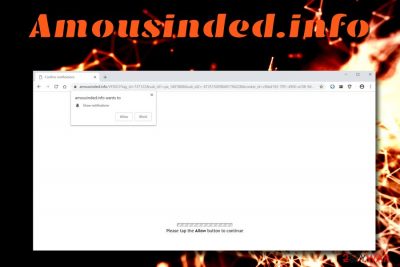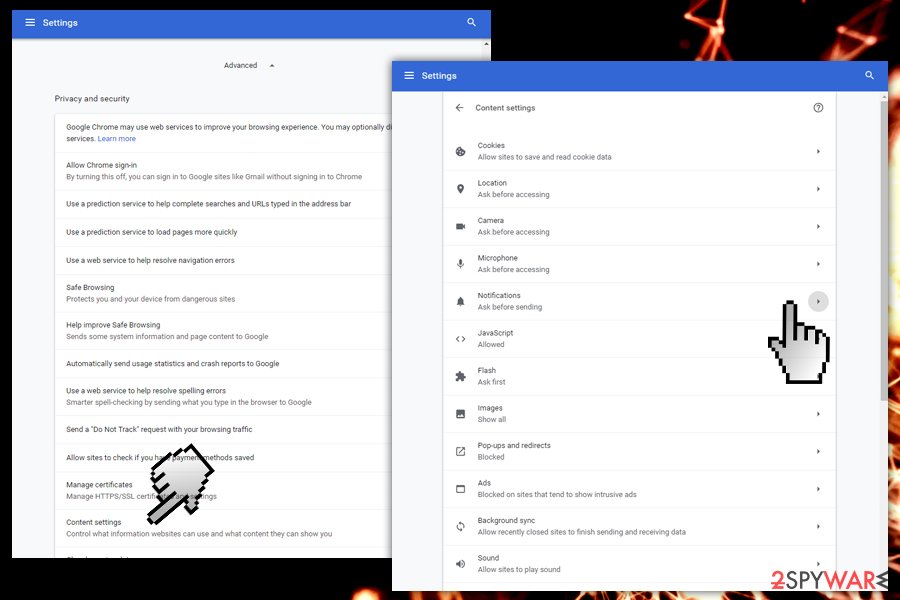Amousinded.info (Easy Removal Guide) - Free Instructions
Amousinded.info Removal Guide
What is Amousinded.info?
Amousinded.info is unsafe domain that asks users to allow push notifications

Amousinded.info is another push notification virus (or allow notifications scam) that is initiated by adware[1] installed on victims' computers. Adware is deceptive software that focuses on advertisement revenue and spams Google Chrome, Internet Explorer, Mozilla Firefox, Safari and other browsers with pop-up ads and redirects. The unwanted application usually gets installed together with other software that users download from the internet and install it by using Recommended/Quick settings. Therefore, the infiltration is generally unnoticed, although the symptoms of Amousinded.info infections can be spotted straight aware. The infected users are often redirected to pages like dh4q.amousinded.info and asked to allow notifications in order to view the content. It is not recommended clicking on any of the options, and take care or Amousinded.info termination instead.
| Summary | |
| Name | Amousinded.info |
| Type | Adware/PUP |
| Infiltration | Software bundling, insecure sites |
| Symptoms | Intrusive redirects, pop-ups, notifications and other commercial content |
| Main dangers | Malware infection and personal data leak |
| Elimination | Use our instructions below and then scan your machine with FortectIntego |
Usually, adware is not dangerous by itself. However, the dubious infiltration techniques, redirects to suspicious websites, web browser settings modifications without permission and similar traits can make adware just as dangerous as malware. Therefore, it is vital to remove Amousinded.info virus from your PC as soon as possible.
You can either take a look at our instructions below or use security software that specializes in PUP elimination. Note that Amousinded.info pop-up appearance not necessarily means any sort of infection, because you can simply be redirected from a malicious website. In such a case, simply shut down the newly opened tab and perform a scan with FortectIntego or other security software just to be sure.
Some users might be surprised by a redirect, especially if they never encountered a push notification virus before (such as Codeprogressee.info, Ncontentdelivery.info, Nuclearlytu.info, and many others. These type of social engineering attacks became extremely popular in recent months, as they seem to be especially effective. Once Amousinded.info notifications are allowed, users will be forced to see pop-up ads that can lead to phishing, spam, malware-laden, or other dangerous websites. The only way to stop these messages is by performing Amousinded.info removal and resetting the browser or stopping notifications.
Additionally, Amousinded.info virus might collect non-personally identifiable information about you, which includes, but is not limited to:
- IP address;
- Sites visited;
- Links clicked;
- Bookmarks added;
- Duration of visits;
- Technical data;
- Cookies, etc.
This data is gathered with the help of tracking technologies like web beacons,[2] cookies and JavaScript in order to display targeted ads which increase the traffic to websites that sponsor Amousinded.info, generating advertisement revenue in the meantime.
If you see Amousinded.info pop-ups on your browser, do not ignore them, as it can compromise your virtual safety and computer security.

Software bundling – deceptive but effective adware distribution method
Adware is usually propagated with the help of other free software. Freeware developers often choose pay-per-install scheme when they collaborate with other software authors. Unfortunately, that “other software” is usually unsafe so bundled software should not be overlooked. Unfortunately, some people are still unaware of this questionable distribution technique which results in many users wondering why are their browsers acting negatively.
While adware removal is usually not a complicated process, the best would be to avoid it entirely. IT specialists[3] recommend to use precaution measures:
- Install anti-malware software that can detect and eliminate PUPs;
- Carefully choose your software source – avoid dodgy third-party sites;
- When the installation wizard shows up, make sure you read the installation instructions carefully;
- Select Advanced settings and remove all the ticks next to add-ons, media players, file converters, system optimization software, and similar useless programs.
Get rid of Amousinded.info and other unwanted software
Fortunately, Amousinded.info removal should not be a complicated task. You can follow our detailed instructions below: eliminate all suspicious entries first and then reset each of the affected browsers.
However, if you have been suffering from invasive ads, persistent redirects, slow browser, lagging computer and similar issues, we highly advise you download and install security software and remove Amousinded.info and any other PUPs/malware on your PC.
If you allowed Amousinded.info notifications, you should revert the change by modifying browser settings. You can follow these steps for Google Chrome:
- Pick Menu > Settings
- Click on Advanced
- Under Privacy and security click on Content Settings > Notifications
- Look for any suspicious entries under Allow
- Remove Amousinded.info notifications

Mozilla Firefox:
- Go to Menu > Options
- Click on Privacy & Security
- Under Permissions click on Notifications > Settings
- Find the dubious entries and select Block from the drop-down menu
Safari:
- Go to Safari > Preferences
- Pick Notifications
- Select Deny for websites you would not want to receive notifications from
MS Edge:
- Click on More > Settings > View advanced settings
- Click Manage under Notifications
- Click on the switch to disable unwanted notifications from the website
You may remove virus damage with a help of FortectIntego. SpyHunter 5Combo Cleaner and Malwarebytes are recommended to detect potentially unwanted programs and viruses with all their files and registry entries that are related to them.
Getting rid of Amousinded.info. Follow these steps
Uninstall from Windows
To remove Amousinded.info PUP from Windows, follow these steps:
Instructions for Windows 10/8 machines:
- Enter Control Panel into Windows search box and hit Enter or click on the search result.
- Under Programs, select Uninstall a program.

- From the list, find the entry of the suspicious program.
- Right-click on the application and select Uninstall.
- If User Account Control shows up, click Yes.
- Wait till uninstallation process is complete and click OK.

If you are Windows 7/XP user, proceed with the following instructions:
- Click on Windows Start > Control Panel located on the right pane (if you are Windows XP user, click on Add/Remove Programs).
- In Control Panel, select Programs > Uninstall a program.

- Pick the unwanted application by clicking on it once.
- At the top, click Uninstall/Change.
- In the confirmation prompt, pick Yes.
- Click OK once the removal process is finished.
Delete from macOS
If your Mac is affected by a potentially unwanted program, check out these instructions:
Remove items from Applications folder:
- From the menu bar, select Go > Applications.
- In the Applications folder, look for all related entries.
- Click on the app and drag it to Trash (or right-click and pick Move to Trash)

To fully remove an unwanted app, you need to access Application Support, LaunchAgents, and LaunchDaemons folders and delete relevant files:
- Select Go > Go to Folder.
- Enter /Library/Application Support and click Go or press Enter.
- In the Application Support folder, look for any dubious entries and then delete them.
- Now enter /Library/LaunchAgents and /Library/LaunchDaemons folders the same way and terminate all the related .plist files.

Remove from Microsoft Edge
Delete unwanted extensions from MS Edge:
- Select Menu (three horizontal dots at the top-right of the browser window) and pick Extensions.
- From the list, pick the extension and click on the Gear icon.
- Click on Uninstall at the bottom.

Clear cookies and other browser data:
- Click on the Menu (three horizontal dots at the top-right of the browser window) and select Privacy & security.
- Under Clear browsing data, pick Choose what to clear.
- Select everything (apart from passwords, although you might want to include Media licenses as well, if applicable) and click on Clear.

Restore new tab and homepage settings:
- Click the menu icon and choose Settings.
- Then find On startup section.
- Click Disable if you found any suspicious domain.
Reset MS Edge if the above steps did not work:
- Press on Ctrl + Shift + Esc to open Task Manager.
- Click on More details arrow at the bottom of the window.
- Select Details tab.
- Now scroll down and locate every entry with Microsoft Edge name in it. Right-click on each of them and select End Task to stop MS Edge from running.

If this solution failed to help you, you need to use an advanced Edge reset method. Note that you need to backup your data before proceeding.
- Find the following folder on your computer: C:\\Users\\%username%\\AppData\\Local\\Packages\\Microsoft.MicrosoftEdge_8wekyb3d8bbwe.
- Press Ctrl + A on your keyboard to select all folders.
- Right-click on them and pick Delete

- Now right-click on the Start button and pick Windows PowerShell (Admin).
- When the new window opens, copy and paste the following command, and then press Enter:
Get-AppXPackage -AllUsers -Name Microsoft.MicrosoftEdge | Foreach {Add-AppxPackage -DisableDevelopmentMode -Register “$($_.InstallLocation)\\AppXManifest.xml” -Verbose

Instructions for Chromium-based Edge
Delete extensions from MS Edge (Chromium):
- Open Edge and click select Settings > Extensions.
- Delete unwanted extensions by clicking Remove.

Clear cache and site data:
- Click on Menu and go to Settings.
- Select Privacy, search and services.
- Under Clear browsing data, pick Choose what to clear.
- Under Time range, pick All time.
- Select Clear now.

Reset Chromium-based MS Edge:
- Click on Menu and select Settings.
- On the left side, pick Reset settings.
- Select Restore settings to their default values.
- Confirm with Reset.

Remove from Mozilla Firefox (FF)
Reset Mozilla Firefox as soon as adware is eliminated:
Remove dangerous extensions:
- Open Mozilla Firefox browser and click on the Menu (three horizontal lines at the top-right of the window).
- Select Add-ons.
- In here, select unwanted plugin and click Remove.

Reset the homepage:
- Click three horizontal lines at the top right corner to open the menu.
- Choose Options.
- Under Home options, enter your preferred site that will open every time you newly open the Mozilla Firefox.
Clear cookies and site data:
- Click Menu and pick Settings.
- Go to Privacy & Security section.
- Scroll down to locate Cookies and Site Data.
- Click on Clear Data…
- Select Cookies and Site Data, as well as Cached Web Content and press Clear.

Reset Mozilla Firefox
If clearing the browser as explained above did not help, reset Mozilla Firefox:
- Open Mozilla Firefox browser and click the Menu.
- Go to Help and then choose Troubleshooting Information.

- Under Give Firefox a tune up section, click on Refresh Firefox…
- Once the pop-up shows up, confirm the action by pressing on Refresh Firefox.

Remove from Google Chrome
Delete malicious extensions from Google Chrome:
- Open Google Chrome, click on the Menu (three vertical dots at the top-right corner) and select More tools > Extensions.
- In the newly opened window, you will see all the installed extensions. Uninstall all the suspicious plugins that might be related to the unwanted program by clicking Remove.

Clear cache and web data from Chrome:
- Click on Menu and pick Settings.
- Under Privacy and security, select Clear browsing data.
- Select Browsing history, Cookies and other site data, as well as Cached images and files.
- Click Clear data.

Change your homepage:
- Click menu and choose Settings.
- Look for a suspicious site in the On startup section.
- Click on Open a specific or set of pages and click on three dots to find the Remove option.
Reset Google Chrome:
If the previous methods did not help you, reset Google Chrome to eliminate all the unwanted components:
- Click on Menu and select Settings.
- In the Settings, scroll down and click Advanced.
- Scroll down and locate Reset and clean up section.
- Now click Restore settings to their original defaults.
- Confirm with Reset settings.

Delete from Safari
Remove unwanted extensions from Safari:
- Click Safari > Preferences…
- In the new window, pick Extensions.
- Select the unwanted extension and select Uninstall.

Clear cookies and other website data from Safari:
- Click Safari > Clear History…
- From the drop-down menu under Clear, pick all history.
- Confirm with Clear History.

Reset Safari if the above-mentioned steps did not help you:
- Click Safari > Preferences…
- Go to Advanced tab.
- Tick the Show Develop menu in menu bar.
- From the menu bar, click Develop, and then select Empty Caches.

After uninstalling this potentially unwanted program (PUP) and fixing each of your web browsers, we recommend you to scan your PC system with a reputable anti-spyware. This will help you to get rid of Amousinded.info registry traces and will also identify related parasites or possible malware infections on your computer. For that you can use our top-rated malware remover: FortectIntego, SpyHunter 5Combo Cleaner or Malwarebytes.
How to prevent from getting adware
Stream videos without limitations, no matter where you are
There are multiple parties that could find out almost anything about you by checking your online activity. While this is highly unlikely, advertisers and tech companies are constantly tracking you online. The first step to privacy should be a secure browser that focuses on tracker reduction to a minimum.
Even if you employ a secure browser, you will not be able to access websites that are restricted due to local government laws or other reasons. In other words, you may not be able to stream Disney+ or US-based Netflix in some countries. To bypass these restrictions, you can employ a powerful Private Internet Access VPN, which provides dedicated servers for torrenting and streaming, not slowing you down in the process.
Data backups are important – recover your lost files
Ransomware is one of the biggest threats to personal data. Once it is executed on a machine, it launches a sophisticated encryption algorithm that locks all your files, although it does not destroy them. The most common misconception is that anti-malware software can return files to their previous states. This is not true, however, and data remains locked after the malicious payload is deleted.
While regular data backups are the only secure method to recover your files after a ransomware attack, tools such as Data Recovery Pro can also be effective and restore at least some of your lost data.
- ^ Adware. Trend Micro. Security Blog.
- ^ Vangie Beal. Web beacon. Webopedia. Online Tech Dictionary.
- ^ ZonderVirus. ZonderVirus. Cybersecurity experts.
























